物理学专业英语
- 格式:pptx
- 大小:1.83 MB
- 文档页数:20
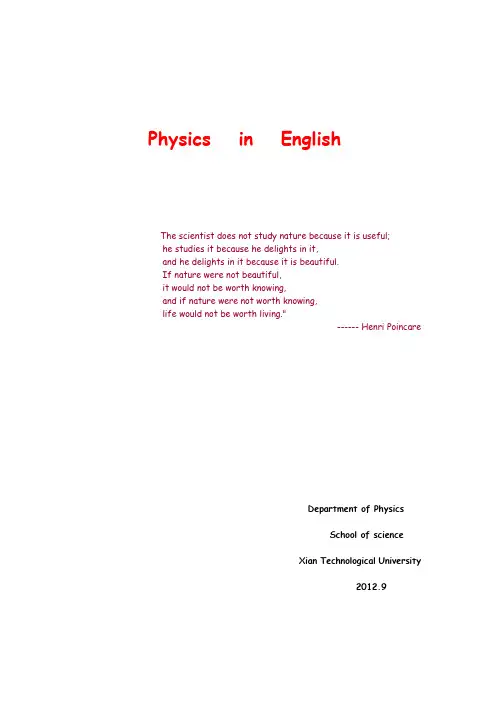
Physics in EnglishThe scientist does not study nature because it is useful;he studies it because he delights in it,and he delights in it because it is beautiful.If nature were not beautiful,it would not be worth knowing,and if nature were not worth knowing,life would not be worth living."------ Henri PoincareDepartment of PhysicsSchool of scienceXian Technological University 2012.9Chapter 1 What is Physics?Physics is natural science studying nature's LawsPhysics was called natural philosophy and fundamental science.The history of physicsThe history of physics encompasses two broad time periods in which classical physics and modern physics developed. Classical physics developed between 1600 and 1900. It embraces the general areas of physics known as mechanics, thermodynamics, and electromagnetism, culminating in relativity. Modern physics began developing between about 1890 and 1930, when it was realized that classical physics could not account for the newly discovered behavior of nature at the atomic and molecular level. Modern physics includes the theory of relativity as well as quantum mechanics and most of the subsequent new physics discovered and developed during the 20th century.Classical physicsClassical physics includes the traditional branches and topics that were recognized and well-developed before the beginning of the 20th century—classical mechanics, optics, thermodynamics, and electromagnetism. Classical mechanics is concerned with bodies acted on by forces and bodies in motion and may be divided into statics (study of the forces on a body or bodies at rest), kinematics (study of motion without regard to its causes), and dynamics (study of motion and the forces that affect it); Acoustics, the study of sound, is often considered a branch of mechanics because sound is due to the motions of the particles of air or other medium through which sound waves can travel and thus can be explained in terms of the laws of mechanics. Among the important modern branches of acoustics is ultrasonics, the study of sound waves of very high frequency beyond the range of human hearing. Optics, the study of light, is concerned not only with visible light but also with infrared and ultraviolet radiation, which exhibit all of the phenomena of visible light except visibility, e.g., reflection, refraction, interference, diffraction, dispersion, and polarization of light. Heat is a form of energy, the internal energy possessed by the particles of which a substance is composed; thermodynamics deals with the relationships between heat and other forms of energy. Electricity and magnetism have been studied as a single branch of physics since the intimate connection between them was discovered in the early 19th century; an electric current gives rise to a magnetic field and a changing magnetic field induces an electric current. Electrostatics deals with electric charges at rest, electrodynamics with moving charges, and magnetostatics with magnetic poles at restThe Emergence of Classical PhysicsClassical mechanics has its roots in the work of Johannes Kepler, who, between 1600 and 1619, became the first person to describe quantitatively and accurately the elliptic paths of the planets around the Sun.The problem of the shape of the planetary orbits was not easy to solve, because all historical observations of the planets were made from the Earth, itself a moving planet. Although a crude heliocentric(Sun-centered) model of the solar system using circular orbits was proposed by the Greek astronomer Aristarchus in the third century B.C. and resurrected by Copernicus in 1542,the planetary positions predicted by Copernicus were not as accurate as those found using Ptolemy's complicated geocentric (Earth-centered} model of the second century A.D.The pure Copernican model was inaccurate because Copernicus refused to abandon the flawed concept of early Greek thought that the natural path of a moving "perfect" celestial object, such as a planet, had to be in the shape of the "perfect" geometrical figure---a circle---with the planet moving at constant speed. a scientist living at the time of Copernicus would have been forced to reject the Copernican theory with its circular planetary orbits, since they did not account for the observed motions of the planets as accurately as the existing, but more complicated, geocentric theory of Ptolemy.The change from the accurate but complex Ptolemaic geocentric model of the solar system to the accurate and simple heliocentric model of Kepler illustrates the characteristics of a good theory. With Kepler's work, accuracy and simplicity blossomed simultaneously from the heliocentric hypothesis. Kepler's model and mathematical methods began the development of physics as we know it. His work was a watershed of quantitative thought and a new worldview.Observation of nature and experimental results typically precede the general theories that account for them. The extensive observations of the planets by Tycho Brahe just prior to 1600 provided Kepler with the data he needed to model the solar system accurately and precisely。
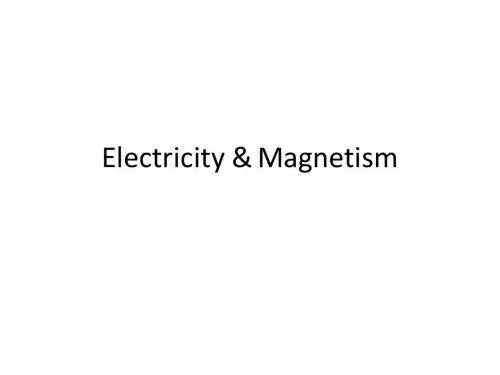
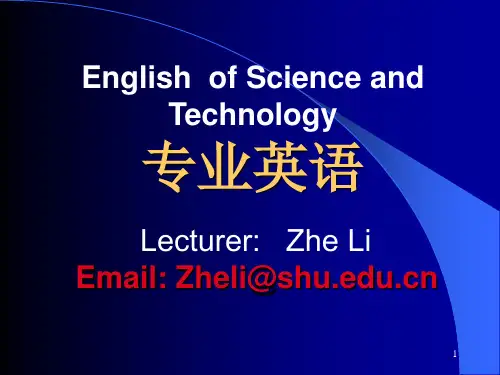
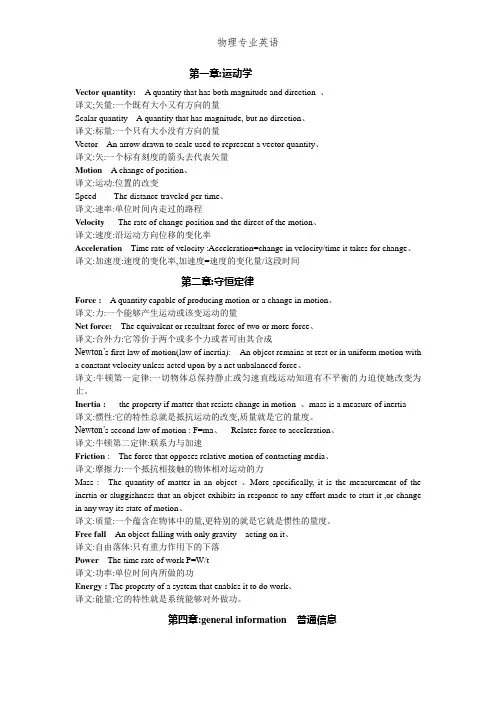
第一章:运动学Vector quantity: A quantity that has both magnitude and direction 、译文;矢量:一个既有大小又有方向的量Scalar quantity A quantity that has magnitude, but no direction、译文:标量:一个只有大小没有方向的量Vector An arrow drawn to scale used to represent a vector quantity、译文:矢:一个标有刻度的箭头去代表矢量Motion A change of position、译文:运动:位置的改变Speed The distance traveled per time、译文:速率:单位时间内走过的路程Velocity The rate of change position and the direct of the motion、译文:速度:沿运动方向位移的变化率Acceleration Time rate of velocity :Acceleration=change in velocity/time it takes for change、译文:加速度:速度的变化率,加速度=速度的变化量/这段时间第二章:守恒定律Force : A quantity capable of producing motion or a change in motion、译文:力:一个能够产生运动或该变运动的量Net force: The equivalent or resultant force of two or more force、译文:合外力:它等价于两个或多个力或者可由其合成Newton’s first law of motion(law of inertia): An object remains at rest or in uniform motion with a constant velocity unless acted upon by a net unbalanced force、译文:牛顿第一定律:一切物体总保持静止或匀速直线运动知道有不平衡的力迫使她改变为止。
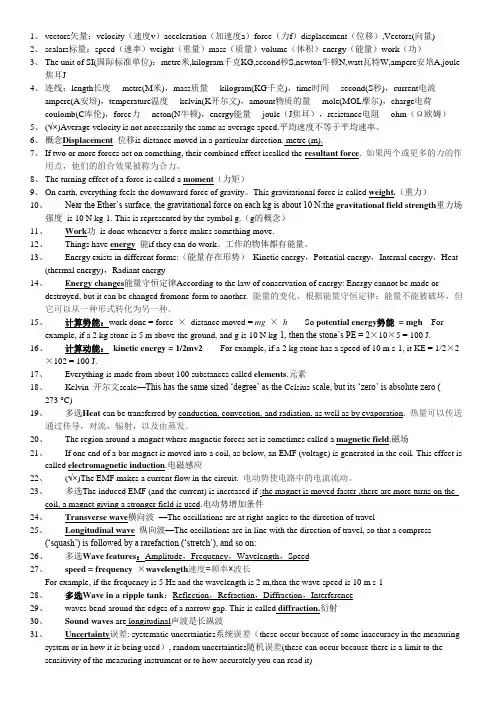
1、vectors矢量:velocity(速度v)acceleration(加速度a)force(力f)displacement(位移),Vectors(向量)2、scalars标量:speed(速率)weight(重量)mass(质量)volume(体积)energy(能量)work(功)3、The unit of SI(国际标准单位):metre米,kilogram千克KG,second秒S,newton牛顿N,watt瓦特W,ampere安培A,joule焦耳J4、连线:length长度----metre(M米),mass质量----kilogram(KG千克),time时间----second(S秒),current电流----ampere(A安培),temperature温度----kelvin(K开尔文),amount物质的量----mole(MOL摩尔),charge电荷----coulomb(C库伦),force力----neton(N牛顿),energy能量----joule(J焦耳),resistance电阻----ohm(Ω欧姆)5、(√×)Average velocity is not necessarily the same as average speed.平均速度不等于平均速率。
6、概念Displacement位移is distance moved in a particular direction. metre (m).7、用点,他们的组合效果被称为合力。
8、The turning effect of a force is called a moment(力矩)9、On earth, everything feels the downward force of gravity。
This gravitational force is called weight.(重力)10、Near the Ether’s surface, the gravitational force on each kg is about 10 N:the gravitational field strength重力场强度is 10 N kg-1. This is represented by the symbol g.(g的概念)11、Work功is done whenever a force makes something move.12、Things have energy能if they can do work。
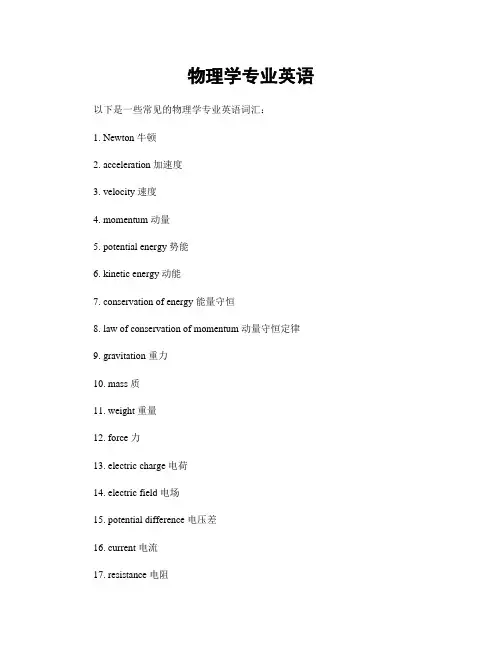
物理学专业英语以下是一些常见的物理学专业英语词汇:1. Newton 牛顿2. acceleration 加速度3. velocity 速度4. momentum 动量5. potential energy 势能6. kinetic energy 动能7. conservation of energy 能量守恒8. law of conservation of momentum 动量守恒定律9. gravitation 重力10. mass 质11. weight 重量12. force 力13. electric charge 电荷14. electric field 电场15. potential difference 电压差16. current 电流17. resistance 电阻18. voltage 电压19. capacitance 电容20. inductance 电感21. quantum mechanics 量子力学22. special relativity 狭义相对论23. general relativity 广义相对论24. elementary particles 基本粒子25. Higgs boson 希格斯玻色子26. antimatter反物质27. virtual particles 虚粒子28. uncertainty principle 不确定性原理29. wave-particle duality 波粒二象性30. quantum entanglement 量子纠缠31. classical mechanics 经典力学32. statistical mechanics 统计力学33. thermodynamics 热力学34. fluid mechanics 流体力学35. optics 光学36. acoustics 声学37. electromagnetism 电磁学38. weak interaction 弱相互作用39. strong interaction 强相互作用40. quantum chromodynamics 量子色动力学。
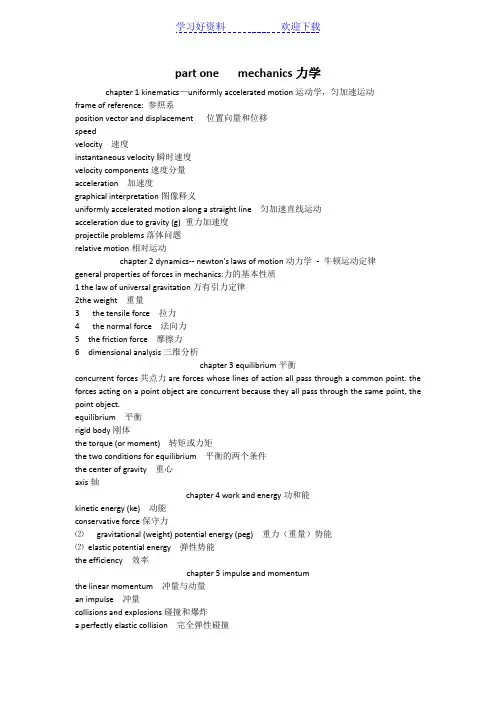
part one mechanics力学chapter 1 kinematics—uniformly accelerated motion运动学,匀加速运动frame of reference: 参照系position vector and displacement 位置向量和位移speedvelocity 速度instantaneous velocity瞬时速度velocity components速度分量acceleration 加速度graphical interpretation图像释义uniformly accelerated motion along a straight line 匀加速直线运动acceleration due to gravity (g) 重力加速度projectile problems落体问题relative motion相对运动chapter 2 dynamics-- newton's laws of motion动力学- 牛顿运动定律general properties of forces in mechanics:力的基本性质1 the law of universal gravitation万有引力定律2the weight 重量3 the tensile force 拉力4 the normal force 法向力5 the friction force 摩擦力6 dimensional analysis三维分析chapter 3 equilibrium平衡concurrent forces共点力are forces whose lines of action all pass through a common point. the forces acting on a point object are concurrent because they all pass through the same point, the point object.equilibrium 平衡rigid body刚体the torque (or moment) 转矩或力矩the two conditions for equilibrium 平衡的两个条件the center of gravity 重心axis轴chapter 4 work and energy功和能kinetic energy (ke) 动能conservative force保守力⑵gravitational (weight) potential energy (peg) 重力(重量)势能⑵elastic potential energy 弹性势能the efficiency 效率chapter 5 impulse and momentumthe linear momentum 冲量与动量an impulse 冲量collisions and explosions碰撞和爆炸a perfectly elastic collision 完全弹性碰撞coefficient of restitution恢复系数the center of mass重心chapter 6 rotation转动the angular speed 角速度the angular acceleration 角加速度tangential 【数】切线;正切centripetal acceleration ( )加速度the centripetal force 向心力chapter 7 rigid-body rotation刚体转动the moment of inertia 转动惯量parallel-axis theorem平行轴定理chapter 8 elasticity弹性elasticity弹性;弹力the stress 【物】应力[u][c]strain 应变the elastic limit弹性极限the shear modulus 切变模量standard atmospheric pressure标准大气压the hydrostatic pressure静水压力equation of continuity连续性方程the viscosity 粘度spring弹簧a restoring force 恢复力simple harmonic motion 简谐运动vibratory motion 振动运动the period ( ) 【数】循环节;周期the frequency ( ) 频率the elastic potential energy 弹性势能the simple pendulum 单摆chapter 11 wave motion波动a propagating wave 波传播wave terminology波术语in-phase vibrations同相振动standing waves驻波conditions for resonance共振的条件longitudinal (compressional) waves 纵向(挤压)波chapter 12 sound声音the intensey (i)强度loudness 响度beats节拍doppler effect 多普勒效应interference effects 干扰效应part two thermodynamics热力学chapter 1 the kinetic theory of gases第1章气体动力学理论avogadro's number ( ) 阿伏伽德罗数()the root mean square speed根均方速度the absolute temperature绝对温度the mean free path (m.f.p.) 平均自由程(m.f.p.)the equipartition theorem of energy 能量均分定理ideal gas law理想气体定律heat 热the internal energy 内部能量an isobaric process is a process carried out at constant pressure. 等压过程是恒压进行的过程。
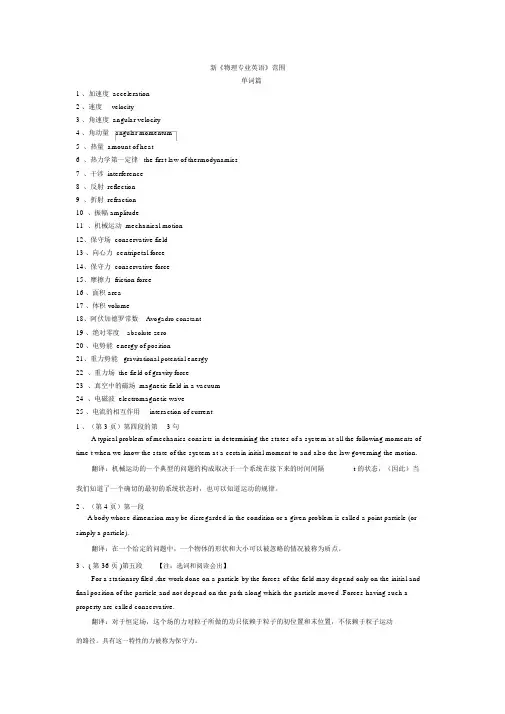
新《物理专业英语》范围单词篇1 、加速度 acceleration2 、速度velocity3 、角速度 angular velocity4 、角动量angular momentum5、热量 amount of heat6、热力学第一定律 the first law of thermodynamics7、干涉 interference8、反射 reflection9、折射 refraction10、振幅 amplitude11、机械运动 mechanical motion12、保守场 conservative field13 、向心力 centripetal force14、保守力 conservative force15、摩擦力 friction force16 、面积 area17 、体积 volume18、阿伏加德罗常数Avogadro constant19 、绝对零度absolute zero20 、电势能 energy of position21、重力势能gravitational potential energy22、重力场 the field of gravity force23、真空中的磁场 magnetic field in a vacuum24、电磁波 electromagnetic wave25 、电流的相互作用interaction of current1 、(第 3 页)第四段的第 3 句A typical problem of mechanics consists in determining the states of a system at all the following moments of time t when we know the state of the system at a certain initial moment to and also the law governing the motion.翻译:机械运动的一个典型的问题的构成取决于一个系统在接下来的时间间隔t 的状态,(因此)当我们知道了一个确切的最初的系统状态时,也可以知道运动的规律。

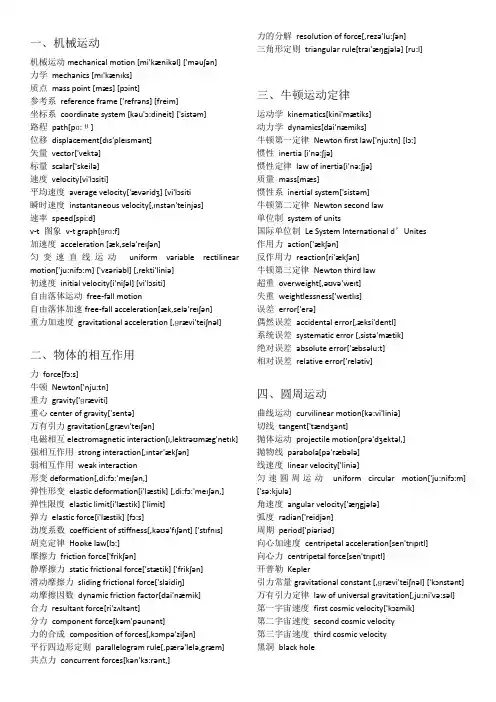
一、机械运动机械运动mechanical motion [mi'kænikəl] ['məuʃən]力学mechanics [mɪ'kænɪks]质点mass point [mæs] [pɔint]参考系reference frame ['refrəns] [freim]坐标系coordinate system [kəu'ɔ:dineit] ['sistəm]路程path[pɑ:θ]位移displacement[dɪs'pleɪsmənt]矢量vector['vektə]标量scalar['skeilə]速度velocity[vi'lɔsiti]平均速度average velocity['ævəridʒ] [vi'lɔsiti瞬时速度instantaneous velocity[,ɪnstən'teinjəs]速率speed[spi:d]v-t 图象v-t graph[ɡrɑ:f]加速度acceleration [æk,selə'reɪʃən]匀变速直线运动uniform variable rectilinear motion['ju:nifɔ:m] ['vɛəriəbl] [,rekti'liniə]初速度initial velocity[i'niʃəl] [vi'lɔsiti]自由落体运动free-fall motion自由落体加速free-fall acceleration[æk,selə'reɪʃən]重力加速度gravitational acceleration [,ɡrævi'teiʃnəl]二、物体的相互作用力force[fɔ:s]牛顿Newton['nju:tn]重力gravity['ɡræviti]重心center of gravity['sentə]万有引力gravitation[,grævɪ'teɪʃən]电磁相互electromagnetic interaction[ɪ,lektrəʊmæg'netɪk]强相互作用strong interaction[,ɪntər'ækʃən]弱相互作用weak interaction形变deformation[,di:fɔ:'meɪʃən,]弹性形变elastic deformation[i'læstik] [,di:fɔ:'meɪʃən,]弹性限度elastic limit[i'læstik] ['limit]弹力elastic force[i'læstik] [fɔ:s]劲度系数coefficient of stiffness[,kəʊə'fɪʃənt] ['stɪfnɪs]胡克定律Hooke law[lɔ:]摩擦力friction force['frikʃən]静摩擦力static frictional force['stætik] ['frikʃən]滑动摩擦力sliding frictional force['slaidiŋ]动摩擦因数dynamic friction factor[dai'næmik]合力resultant force[ri'zʌltənt]分力component force[kəm'pəunənt]力的合成composition of forces[,kɔmpə'ziʃən]平行四边形定则parallelogram rule[,pærə'lelə,græm]共点力concurrent forces[kən'kɜ:rənt,]力的分解resolution of force[,rezə'lu:ʃən]三角形定则triangular rule[traɪ'æŋgjələ] [ru:l]三、牛顿运动定律运动学kinematics[kini'mætiks]动力学dynamics[dai'næmiks]牛顿第一定律Newton first law['nju:tn] [lɔ:]惯性inertia [i'nə:ʃjə]惯性定律law of inertia[i'nə:ʃjə]质量mass[mæs]惯性系inertial system['sistəm]牛顿第二定律Newton second law单位制system of units国际单位制Le System International d’Unites作用力action['ækʃən]反作用力reaction[ri'ækʃən]牛顿第三定律Newton third law超重overweight[,əʊvə'weɪt]失重weightlessness['weɪtlɪs]误差error['erə]偶然误差accidental error[,æksi'dentl]系统误差systematic error [,sistə'mætik]绝对误差absolute error['æbsəlu:t]相对误差relative error['relətiv]四、圆周运动曲线运动curvilinear motion[kə:vi'liniə]切线tangent['tændʒənt]抛体运动projectile motion[prə'dʒektəl,]抛物线parabola[pə'ræbələ]线速度linear velocity['liniə]匀速圆周运动uniform circular motion['ju:nifɔ:m] ['sə:kjulə]角速度angular velocity['æŋgjələ]弧度radian['reidjən]周期period['piəriəd]向心加速度centripetal acceleration[sen'trɪpɪtl]向心力centripetal force[sen'trɪpɪtl]开普勒Kepler引力常量gravitational constant [,ɡrævi'teiʃnəl] ['kɔnstənt]万有引力定律law of universal gravitation[,ju:ni'və:səl]第一宇宙速度first cosmic velocity['kɔzmik]第二宇宙速度second cosmic velocity第三宇宙速度third cosmic velocity黑洞black hole五、能量能量energy['enədʒi]势能potential energy[pə'tenʃəl]动能kinetic energy[kɪ'netɪk, kaɪ-]功work[wə:k]焦耳joule[dʒu:l]功率power['pauə]瓦特watt['pauə]重力势能gravitational potential energy [,ɡrævi'teiʃnəl] [pə'tenʃəl]弹性势能elastic potential energy[i'læstik] [pə'tenʃəl]动能定理theorem of kinetic energy['θi:ərəm] [kɪ'netɪk]机械能mechanical energy[mi'kænikəl]机械能守恒定律law of conservation of mechanical energy[,kɔnsə'veiʃən] [mi'kænikəl]能量守恒定律law of energy conservation[,kɔnsə'veiʃən]拉力traction['trækʃən]轨道obital大小magnatitude方向direction[di'rekʃən]水平horizental竖直vertical['və:tikəl]相互垂直perpendicular[,pɜ:pən'dɪkjələ]坐标coordinate[kəu'ɔ:dineit]直角坐标系cersian coordinate system弹簧spring[spriŋ]球体sphere[sfiə]环loop[lu:p]盘型disc圆柱形cylinder['silində]。
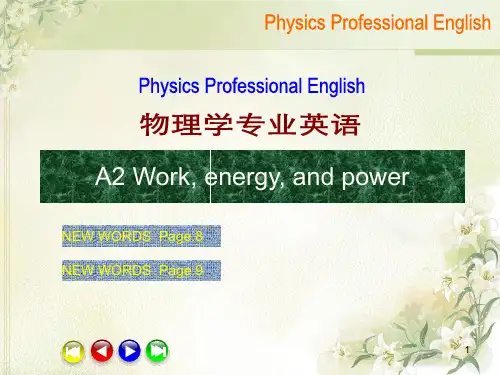
Introduction 1 参考译文:导论 3Chapter 1: Mechanics 61.1 Classical versus quantum 61.2 Einsteinian versus Newtonian 61.3 History 71.4 Types of mechanical bodies 81.5 Sub-disciplines in mechanics 81.5.1 Classical mechanics 81.5.2 Quantum mechanics 9参考译文:第一章力学 91.1 经典和量子 91.2 爱因斯坦和牛顿 101.3力学的历史 101.4力学中物体的种类 111.5力学的分支学科 111.5.1经典力学有如下学科构成: 111.5.2量子力学 12Chapter 2: Heat 132.1 Overview 132.2 Notation 142.3 Definitions 152.4 Thermodynamics 152.4.1 Internal energy 152.4.2 Heat capacity 162.4.3 Phase Changes 172.5 Heat transfer mechanisms 17 2.6 Heat dissipation 19参考译文:第二章热学 202.1 综述 202.2 符号 212.3 定义 212.4 热力学 212.4.1 内能 212.4.2 热容量 222.4.3 相变 232.5 热传递的机制 232.6 散热 24Chapter 3: Electromagnetism 25 3.1 History 253.2 Overview 273.3 Classical electrodynamics 27 3.4 The photoelectric effect 28 3.5 Maxwell's equations 293.6 Special relativity 30参考译文:第三章电磁学 343.1 发展历史 353.2 总论 363.3 经典电动力学 363.4 光电效应 373.5 麦克斯韦方程组 373.6 狭义相对论 37Chapter 4 Optics 414.1 History 414.2 Classical optics 434.2.1 Geometrical optics 44 4.2.2 Physical optics 46 4.3 Modern optics 514.3.1 Lasers 524.3.2 Nonlinear optics 59 参考译文:第四章光学 59 4.1 光学的历史 604.2 经典光学 614.2.1 几何光学 614.2.2 物理光学 634.3 现代光学 664.3.1激光 664.3.2 非线性光学 71Chapter 5 Atomic physics 725.1 Isolated atoms 725.2 Electronic configuration 725.3 History and developments 735.3.1 Introduction to Atomic Physics 74 5.3.2 Atomic Structure 745.3.3 Bohr atom structure model 755.3.4 Atomic Isotopes 765.3.5 Einstein's Equation 765.3.6 Radioactive Decay 77参考译文:第五章原子物理 795.1 孤立原子 795.2 电子图像 795.3 原子物理的历史和发展过程 805.3.1 原子物理引论 805.3.2 原子结构 805.3.3波尔的原子结构模型 815.3.4 原子的同位素 815.3.5 爱因斯坦方程 825.3.6 放射性衰变 82Chapter 6: Quantum mechanics 846.1 Overview 856.2 Quantum mechanics and classical physics 86 6.3 Theory 866.4 Mathematical formulation 89。
第一章:运动学Vector quantity: A quantity that has both magnitude and direction .译文;矢量:一个既有大小又有方向的量Scalar quantity A quantity that has magnitude, but no direction.译文:标量:一个只有大小没有方向的量Vector An arrow drawn to scale used to represent a vector quantity.译文:矢:一个标有刻度的箭头去代表矢量Motion A change of position.译文:运动:位置的改变Speed The distance traveled per time.译文:速率:单位时间内走过的路程Velocity The rate of change position and the direct of the motion.译文:速度:沿运动方向位移的变化率Acceleration Time rate of velocity :Acceleration=change in velocity/time it takes for change.译文:加速度:速度的变化率,加速度=速度的变化量/这段时间第二章:守恒定律Force : A quantity capable of producing motion or a change in motion.译文:力:一个能够产生运动或该变运动的量Net force:The equivalent or resultant force of two or more force.译文:合外力:它等价于两个或多个力或者可由其合成Newton’s first law of motion(law of inertia):An object remains at rest or in uniform motion with a constant velocity unless acted upon by a net unbalanced force.译文:牛顿第一定律:一切物体总保持静止或匀速直线运动知道有不平衡的力迫使他改变为止。
机械运动mechanical motion [mi'kænikəl] ['məuʃən] 力学mechanics [mɪ'kænɪks]质点mass point [mæs] [pɔint]参考系reference frame ['refrəns] [freim]坐标系coordinate system [kəu'ɔ:dineit] ['sistəm]路程path[pɑ:θ]位移displacement[dɪs'pleɪsmənt]矢量vector['vektə]标量scalar['skeilə]速度velocity[vi'lɔsiti]平均速度average velocity['ævəridʒ] [vi'lɔsiti瞬时速度instantaneous velocity[,ɪnstən'teinjəs]速率speed[spi:d]v-t图象v-t graph[ɡrɑ:f]加速度acceleration [æk,selə'reɪʃən]匀变速直线运动uniformvariablerectilinear motion['ju:nifɔ:m] ['vɛəriəbl] [,rekti'liniə]初速度initial velocity[i'niʃəl] [vi'lɔsiti]自由落体运动free-fall motion自由落体加速free-fall acceleration[æk,selə'reɪʃən]重力加速度gravitational acceleration [,ɡrævi'teiʃnəl]二、物体的相互作用力force[fɔ:s]牛顿Newton['nju:tn]重力gravity['ɡræviti]重心center of gravity['sentə]万有引力gravitation[,grævɪ'teɪʃən]电磁相互electromagnetic interaction[ɪ,lektrəʊmæg'netɪk] 强相互作用strong interaction[,ɪntər'ækʃən]弱相互作用weak interaction形变deformation[,di:fɔ:'meɪʃən,]弹性形变elastic deformation[i'læstik] [,di:fɔ:'meɪʃən,]弹性限度elastic limit[i'læstik] ['limit]弹力elastic force[i'læstik] [fɔ:s]劲度系数coefficient of stiffness[,kəʊə'fɪʃənt] ['stɪfnɪs]胡克定律Hooke law[lɔ:]摩擦力friction force['frikʃən]静摩擦力static frictional force['stætik] ['frikʃən]滑动摩擦力sliding frictional force['slaidiŋ]动摩擦因数dynamic friction factor[dai'næmik]合力resultant force[ri'zʌltənt]分力component force[kəm'pəunənt]力的合成composition of forces[,kɔmpə'ziʃən]三角形定则triangularrule[traɪ'æŋgjələ] [ru:l]三、牛顿运动定律运动学kinematics[kini'mætiks]动力学dynamics[dai'næmiks]牛顿第一定律Newton first law['nju:tn] [lɔ:]惯性inertia [i'nə:ʃjə]惯性定律law of inertia[i'nə:ʃjə]质量mass[mæs]惯性系inertial system['sistəm]牛顿第二定律Newton second law单位制system of units国际单位制Le System International d’Unites作用力action['ækʃən]反作用力reaction[ri'ækʃən]牛顿第三定律Newton third law超重overweight[,əʊvə'weɪt]失重weightlessness['weɪtlɪs]误差error['erə]偶然误差accidental error[,æksi'dentl]系统误差systematic error [,sistə'mætik]绝对误差absolute error['æbsəlu:t]相对误差relative error['relətiv]四、圆周运动曲线运动curvilinear motion[kə:vi'liniə]切线tangent['tændʒənt]抛体运动projectile motion[prə'dʒektəl,]抛物线parabola[pə'ræbələ]线速度linear velocity['liniə]匀速圆周运动uniformcircularmotion['ju:nifɔ:m]['sə:kjulə]角速度angular velocity['æŋgjələ]弧度radian['reidjən]周期period['piəriəd]向心加速度centripetal acceleration[sen'trɪpɪtl]向心力centripetalforce[sen'trɪpɪtl]开普勒Kepler引力常量gravitational constant [,ɡrævi'teiʃnəl] ['kɔnstənt]万有引力定律law of universal gravitation[,ju:ni'və:səl]第一宇宙速度first cosmic velocity['kɔzmik]第二宇宙速度second cosmic velocity第三宇宙速度third cosmic velocity能量energy['enədʒi]势能potential energy[pə'tenʃəl]动能kinetic energy[kɪ'netɪk, kaɪ-]功work[wə:k]焦耳joule[dʒu:l]功率power['pauə]瓦特watt['pauə]重力势能gravitational potential energy [,ɡrævi'teiʃnəl] [pə'tenʃəl]弹性势能elastic potential energy[i'læstik] [pə'tenʃəl]动能定理theorem of kinetic energy['θi:ərəm] [kɪ'netɪk]机械能mechanical energy[mi'kænikəl]机械能守恒定律law of conservation of mechanical energy[,kɔnsə'veiʃən] [mi'kænikəl]能量守恒定律law of energy conservation[,kɔnsə'veiʃən]拉力traction['trækʃən]轨道obital大小magnatitude方向direction[di'rekʃən]水平horizental竖直vertical['və:tikəl]相互垂直perpendicular[,pɜ:pən'dɪkjələ]坐标coordinate[kəu'ɔ:dineit]直角坐标系cersian coordinate system弹簧spring[spriŋ]球体sphere[sfiə]环loop[lu:p]盘型disc圆柱形cylinder['silində]。
物理学专业英语词汇摘要:物理学是一门研究自然界最基本的规律和现象的科学,它涉及到许多专业的英语词汇,对于物理学专业的学习者来说,掌握这些词汇是非常重要的。
本文根据物理学的不同分支,整理了一些常用的物理学专业英语词汇,并用表格的形式给出了中文和英文的对照,以便于读者查阅和记忆。
本文旨在为物理学专业的学习者提供一个参考资料,帮助他们提高英语水平和物理知识。
1. 基础物理 Basic Physics中文英文物理量physical quantity物理单位physical unit标准单位standard unit国际单位制International System of Units (SI)基本量base quantity导出量derived quantity标量scalar矢量vector位移displacement速度velocity加速度acceleration力force动量momentum动能kinetic energy势能potential energy能量守恒conservation of energy功work功率power压强pressure浮力buoyancy摩擦力friction force弹力elastic force重力gravity force引力常数gravitational constant圆周运动circular motion向心力centripetal force简谐振动simple harmonic motion振幅amplitude频率frequency周期period2. 热学 Thermodynamics中文英文温度temperature热力学温标thermodynamic temperature scale 开尔文温标Kelvin temperature scale摄氏温标Celsius temperature scale华氏温标Fahrenheit temperature scale热平衡thermal equilibrium热力学第零定律zeroth law of thermodynamics热量heat热容量heat capacity比热容specific heat capacity理想气体定律ideal gas law普适气体常数universal gas constant3. 光学 Optics中文英文光light光源light source光线light ray光束light beam光波light wave波长wavelength频率frequency振幅amplitude相位phase干涉interference衍射diffraction偏振polarization光速speed of light折射率refractive index折射定律law of refraction反射定律law of reflection全反射total reflection透镜lens镜头lens焦距focal length焦点focus物镜objective lens可见光visible light紫外光ultraviolet light红外光infrared light4. 电学 Electricity中文英文电荷electric charge电流electric current电压electric voltage电阻electric resistance电阻率resistivity电容electric capacitance电容率permittivity5. 原子物理 Atomic Physics中文英文原子atom原子核atomic nucleus原子序数atomic number原子量atomic mass原子半径atomic radius原子轨道atomic orbit电子electron质子proton中子neutron电子云electron cloud电子壳层electron shell价电子valence electron离子ion同位素isotope同素异形体allotrope核裂变nuclear fission核聚变nuclear fusion核反应堆nuclear reactor核武器nuclear weapon6. 量子物理 Quantum Physics中文英文量子quantum量子力学quantum mechanics量子场论quantum field theory量子数quantum number量子态quantum state量子纠缠quantum entanglement量子隧穿quantum tunneling测不准原理uncertainty principle薛定谔方程Schrödinger equation海森堡矩阵力学Heisenberg matrix mechanics 7. 固体物理 Solid State Physics中文英文固体solid晶体crystal晶格lattice晶胞unit cell晶面指数Miller index点阵常数lattice constant点缺陷point defect线缺陷line defect8. 电磁学 Electromagnetism中文英文电荷electric charge电流electric current电场electric field电势electric potential电压electric voltage电阻electric resistance电阻率resistivity电容electric capacitance电容率permittivity电感electric inductance电磁感应electromagnetic induction电磁波electromagnetic wave磁场magnetic field磁通量magnetic flux磁感应强度magnetic induction intensity磁化率magnetic susceptibility磁导率magnetic permeability9. 光子学 Photonics中文英文光子photon光源light source光纤optical fiber光波导optical waveguide光谱spectrum光谱仪spectrometer激光器laser半导体激光器semiconductor laser激光二极管laser diode发光二极管light-emitting diode (LED)光探测器photodetector光电倍增管photomultiplier tube (PMT) 10. 流体力学 Fluid Mechanics中文英文流体fluid气体gas液体liquid粘性viscosity粘滞力viscous force流速flow velocity流量flow rate流线streamline管流pipe flow层流laminar flow湍流turbulent flow雷诺数Reynolds number伯努利方程Bernoulli's equation压力差pressure difference水头head水锤现象water hammer11. 波动光学 Wave Optics中文英文光波light wave波前wavefront光程差optical path difference干涉条纹interference fringe干涉仪interferometer杨氏双缝实验Young's double-slit experiment 迈克尔逊干涉仪Michelson interferometer法布里-珀罗干涉仪Fabry-Perot interferometer衍射现象diffraction phenomenon衍射级数diffraction order中文英文衍射极限diffraction limit单缝衍射single-slit diffraction双缝衍射double-slit diffraction12. 相对论 Relativity中文英文相对论relativity狭义相对论special relativity广义相对论general relativity惯性系inertial frame参考系reference frame洛伦兹变换Lorentz transformation洛伦兹收缩Lorentz contraction时间膨胀time dilation质能方程mass-energy equation光速不变原理principle of constancy of light speed 相对性原理principle of relativity引力场gravitational field引力波gravitational wave弯曲的时空curved spacetime13. 核物理 Nuclear Physics中文英文核物理nuclear physics原子核atomic nucleus核子nucleon质子proton中子neutron核力nuclear force核结合能nuclear binding energy核裂变nuclear fission核聚变nuclear fusion放射性元素radioactive element放射性衰变radioactive decay半衰期half-lifeα衰变alpha decayβ衰变beta decay。